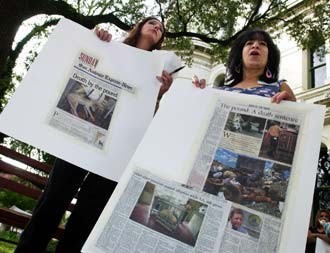|
Citizens howl about city pound Hundreds of concerned citizens poured into the SBC Technology Center at St. Mary's University last week - so many that the fire marshal was summoned to clear doorways - for a town hall meeting about practices at the City's Animal Care and Control Center. "The public is here to voice their concerns and outrage," said Laura Stanford, founder of Citizens for Pound Adoption Change. "They want a change from the city pound." The meeting was called by District 7 City Councilman and mayoral candidate Julian Castro, who said he is working towards a "no kill" policy at the facility, where temporary shelter would be provided to stray animals until they could be placed in a loving home. In the meantime, he said, animals who are euthanized should no longer be gassed to death. "Lethal injection should replace carbon monoxide euthanasia immediately, if, according to scientific analysis, lethal injection is more humane." Last month, the Express-News series "Death by the Pound" revealed that San Antonio's facility kills more animals per capita - 50,000 - than any other major U.S. city. The series also questioned the treatment of the animals housed in the facility. Shortly after the series ran, San Antonians, including another mayoral hopeful, Jay Tope, protested in front of City Hall as a prelude to the November 23 town hall meeting. "It's not going to fall on deaf ears anymore," Tope said. "We need a big dose of common sense." Like Castro, Tope said he wants to make San Antonio a "no kill city." "People don't know that it's not a shelter," Sally Tutt said. "It's like throwing them in the trash." However, activists said responsibility must also be placed on pet owners who allow their animals to roam and breed. They proposed that the city pound could pick up the animals, spay, or neuter them, and release them to an area where caretakers will feed them. Another solution would be a spay and neuter ordinance in which every pet owner is required to sterilize their animals, while animal breeders could obtain a permit to exempt them from the ordinance. "The main cause of this is laziness," said Anthony Neira, a member of Stray Cat Adoption of Texas at last week's meeting. "This can be our job, to promote to people the responsibility of spaying and neutering." At the November 23 meeting, Dr. William Lammers, who is in charge of the facility, spoke about the procedures and policies at the facility. He claimed that the pound lacks staff who can coordinate with volunteers to set up animals for adoption. "Everyone who wants to do something about it, I expect you to volunteer," Lammers said. He listed additional problems at the facility, including an inadequate budget, staffing, space, and equipment. "The facility is over 60 years old, and is too small," Lammers said. "It is labor intensive to care for animals. The staff works hard to keep the facility clean." The City plans to complete a new facility by July 2007. As for the gas chambers, Lammers said that some day when funding is received, they would use lethal injections instead. Kathryn Bice, executive director of the Humane Society, began her presentation with a moment of silence to remember sick, abandoned animals that were victims of the animal overpopulation. Through 20 years of experience at the Humane Society, Bice says it took her a trip to San Antonio to see a gas chamber. "Sometimes its not the building that's the problem, but the people and program," Bice said. "To save thousands of animals, we need to move fast. There's room for everyone to help and provide support. Without everyone we would not be able to move forward." • A second hearing was scheduled at City Council Chambers on Tuesday, November 30, after the Current's press deadline. See related story, "Fur fight."
|


